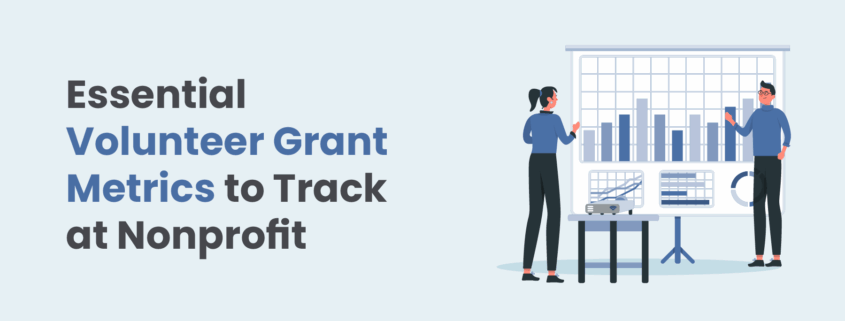Volunteer Grant Metrics to Track at Your Nonprofit
In the ever-evolving landscape of nonprofit management, understanding the metrics that drive volunteer grant programs is essential for maximizing funding opportunities. Volunteer grants, often referred to as Dollars for Doers programs, are a powerful way for nonprofits to leverage the time and effort of their volunteers into financial support.
By tracking specific metrics, organizations can not only assess the effectiveness of their volunteer engagement strategies but also enhance their overall fundraising efforts. In this article, we will explore the key volunteer grant metrics that nonprofits should monitor to ensure success. Let’s begin!
1. Volunteer Grant Completion Rate
The volunteer grant completion rate is a critical metric that reflects the percentage of eligible volunteers who successfully submit a volunteer grant request to their employer. This metric is vital for assessing how effectively your organization encourages volunteers to utilize employer-sponsored grant programs.
Importance of Completion Rate
Understanding the completion rate helps nonprofits identify gaps in their communication and support systems. A low completion rate may indicate that volunteers are unaware of the grant opportunities available to them or that the application process is too cumbersome.
Calculating the Completion Rate
To calculate the volunteer grant completion rate, use the following formula:
(Number of volunteer grant requests submitted) / (Number of eligible volunteers) × 100
By regularly monitoring this metric, nonprofits can implement targeted strategies to improve volunteer engagement and increase grant submissions.
2. Total Volunteer Grant Funding Received
This metric represents the total amount of funding your nonprofit receives through volunteer grant programs. It serves as a direct indicator of the financial support generated through volunteer engagement.
Importance of Total Funding
Tracking total funding received allows organizations to assess the success of their volunteer grant initiatives. It also provides insight into the financial impact of volunteer efforts, which can be leveraged in grant applications and reporting.
Calculating Total Funding
To determine the total volunteer grant funding received, simply sum all volunteer grant funds within a specific period. This metric can be tracked monthly, quarterly, or annually, depending on your organization’s reporting needs.
3. Grant Amount per Volunteer
The average amount of funding received per volunteer grant request is another essential metric. This figure helps nonprofits forecast potential revenue and set realistic targets for their volunteer grant programs.
Importance of Average Grant Amount
Understanding the average grant amount can help organizations identify trends in donor behavior and adjust their strategies accordingly. For instance, if the average grant amount is decreasing, it may be time to reevaluate the messaging or incentives offered to volunteers.
Calculating Average Grant Amount
To calculate the average grant amount per volunteer, use the following formula:
(Total volunteer grant funding received) / (Number of volunteer grant requests submitted)
This metric provides valuable insights into the effectiveness of your volunteer grant initiatives.
4. Number of Companies Providing Volunteer Grants
This metric counts the distinct companies whose employees have submitted volunteer grant requests to your organization. It demonstrates the breadth of corporate partnerships and the potential for expanding your network.
Importance of Corporate Partnerships
Tracking the number of companies involved in your volunteer grant programs can help identify opportunities for collaboration and partnership development. A diverse range of corporate partners can lead to increased funding and support for your nonprofit.
Calculating the Number of Companies
To determine the number of companies providing volunteer grants, simply count the unique companies associated with volunteer grant submissions. This metric can be tracked over time to assess growth in corporate engagement.
5. Volunteer Retention Rate
The volunteer retention rate measures the percentage of volunteers who continue to engage with your organization over a specific period. High retention rates indicate successful volunteer engagement and satisfaction.
Importance of Retention Rate
High retention rates can lead to increased volunteer grant submissions, as engaged volunteers are more likely to participate in grant programs. Understanding this metric can help nonprofits develop strategies to enhance volunteer satisfaction and commitment.
Calculating the Retention Rate
To calculate the volunteer retention rate, use the following formula:
(Number of volunteers at end of period - Number of new volunteers) / (Number of volunteers at start of period) × 100
Regularly monitoring this metric can help organizations identify trends and make necessary adjustments to their volunteer programs.
6. Volunteer Donation Rate
The volunteer donation rate measures the percentage of volunteers who also make personal donations to your organization. This metric is crucial for understanding the overall engagement of your volunteer base.
Importance of Donation Rate
Volunteers who donate are often more engaged and can influence others to participate in volunteer grant programs. Tracking this metric can help nonprofits identify their most committed supporters and tailor their outreach efforts accordingly.
Calculating the Donation Rate
To calculate the volunteer donation rate, use the following formula:
(Number of volunteers who donate) / (Total number of volunteers) × 100
By understanding this metric, organizations can enhance their fundraising strategies and foster a culture of giving among their volunteers.
7. Value of Volunteer Time
The estimated economic value of the time contributed by volunteers is a powerful metric that demonstrates the significant impact of volunteer efforts. This value can be leveraged in grant applications and reporting.
Current Estimate
As of 2024, the estimated value of volunteer time is $34.79 per hour. This figure can be used to quantify the contributions of volunteers and highlight their importance to your organization’s mission.
Importance of Volunteer Time Value
Understanding the value of volunteer time can help nonprofits articulate their impact to stakeholders and potential funders. It also underscores the importance of volunteer engagement in achieving organizational goals.
8. Corporate Volunteer Program Participation Rate
This metric measures the percentage of employees participating in their company’s volunteer programs. Higher participation rates can lead to increased volunteer grant opportunities for your nonprofit.
Current Participation Rate
Currently, 33% of employees participate in corporate volunteer programs. Tracking this metric can help nonprofits identify potential partnerships and enhance their outreach efforts to corporate partners.
Importance of Participation Rate
Understanding the corporate volunteer participation rate can help organizations tailor their messaging and engagement strategies to better connect with potential corporate partners.
9. Volunteer Engagement Level
The volunteer engagement level measures the depth of involvement and commitment of your volunteers. Engaged volunteers are more likely to participate in volunteer grant programs and contribute to your organization’s success.
Importance of Engagement Level
Tracking volunteer engagement levels can help nonprofits identify their most dedicated supporters and develop strategies to enhance overall volunteer satisfaction and retention.
Calculating Engagement Level
To calculate the volunteer engagement level, use the following formula:
(Number of actively engaged volunteers) / (Total number of volunteers) × 100
By monitoring this metric, organizations can gain valuable insights into their volunteer base and make informed decisions about their engagement strategies.
Final Thoughts
By tracking these essential volunteer grant metrics, nonprofits can effectively measure the success of their volunteer grant programs, identify areas for improvement, and enhance overall volunteer engagement and support. Understanding these metrics not only helps organizations maximize their funding opportunities but also fosters a culture of giving and commitment among volunteers.
Maximize Your Volunteer Grant Potential with Double the Donation
Want to see how your volunteer grant efforts could translate into measurable revenue growth? With Double the Donation Volunteering, you can increase volunteer participation, guide supporters through volunteer grant submissions, and establish deeper corporate partnerships all in one place—making it easier to uncover hidden opportunities and showcase your program’s impact.
Discover how the right tools can turn volunteer hours into sustainable funding for your mission. Get a demo today!



